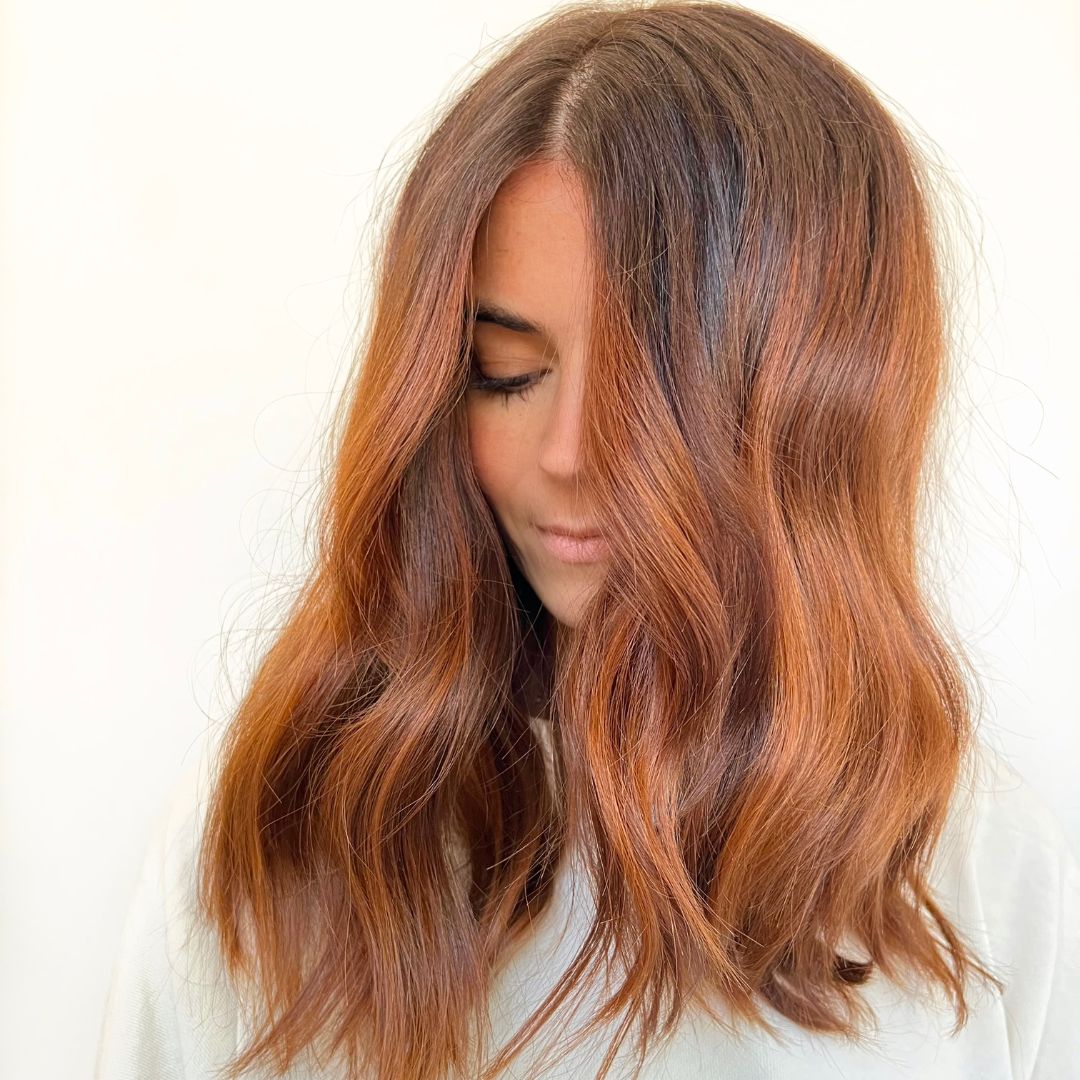

Red Hair Color Formulations
When working with color on redheads, the first thing to know is that red pigment is not only a bigger molecule, it's heavier. Because of this, it’s both the hardest color to get into the cuticle and the hardest to get out.
Making sure this is a tone your client wants long term will prevent a lot of hassle with future appointments. Red color is not recommended for clients that just need a quick change for a little while and then ultimately want to transition to blonde, for example. In this scenario, a formula that easily fades and can be adjusted next time, such as a lighter coppery gloss, could be a good option.
Additionally, reds are beautiful when they’re in layered tones. We often suggest doing multiple glosses starting with a gold, to copper and then finally red. When using permanent color to change the base or entire head, make sure to formulate taking into consideration the underlying tones of the natural hair. Adjusting the developer alone can intensify the tone in the red. Sometimes people formulate too light for the depth needed to create that richness in red hair color. Simply upping the developer with a darker level of color will make something more intense.
Finally, when formulating for over 75% gray on red hair, try using a G as your neutral instead of N. The coverage will be much better and you will get a brighter, richer result.
EXAMPLES OF RED COLOR FORMULAS
For a rich red color, consider trying out the following formulas:
1. Redken Shades EQ : 7C, 8CR, 8GG
2. Redken Chromatics permanent color: 6RV, 6CC, 7CR
3. Redken Chromatics gray coverage: 6G, 5GG, 5C, 6RR
Brunette Hair Color Formulations
When working with brunettes, remember to always keep things warmer. Reflection is important in any hair color, but brunettes have a natural warmth to their hair that needs to be complimented. Creating a flat brunette will result in a much darker appearance that can be harsh on the skin tone. Instead, try picking out the warmth in the eyes and use complementary tones to enhance the features.
When formulating for gray coverage on a brunette, try aiming for a lighter tone around the client’s face. The hair around the face is much finer than elsewhere on the head and can pick up pretty dark for someone that has grays. We sometimes recommend using two separate formulas in order to achieve a balanced color in these situations. The goal is to soften the features and uplift someone who has a lot of gray. Working with too dark of a formula can have the opposite effect.
EXAMPLES OF BRUNETTE COLOR FORMULAS
Brunette never has to be boring! Give these formulas a try for a rich finish:
1. Redken Shades EQ gloss: 6NB, 5N, 6NW
2. Redken Chromatics permanent color: 5G, 6M, 6N
3. Redken Chromatics gray coverage: 6NN, 4M, 6NW
Blonde Hair Color Formulations
The first rule of thumb when working with blondes is that blonde hair will always pull much warmer than you think. When using a permanent color line, you need to understand just how much underlying pigment will be exposed when the hair is lifted. Ammonia based colors always expose more warmth, so when working with higher lift blondes we suggest going with a non-ammonia based color to help control the excess warmth.
Additionally, we rarely suggest using high lift hair color. It exposes far too much underlying pigment and the deposit is not dark enough to combat any of that unnecessary warmth. For this reason, there are very few people that high lift colors actually work for. It’s better to do some form of lightening with a slightly darker root color in order to achieve a natural balance.
You will rarely fight the warmth in underlying pigments, so if someone is very against warmth in their blonde hair try encouraging them to skip the root color and go for a blended balayage. The result will be cooler and allow for a much easier grow out period.
It’s also very important that you make sure you are formulating with the correct level and developer. To make this easy, always count the level you are moving from as the first level. For example, going from a level 6 to a level 8 is a change of 3 levels. So, 30 volume developer would be needed for this service.
Finally, the more gray someone has, the better the blonde. Remember that the swatches from your color line are all based on white hair. Gray hair is not really gray, it’s white hair mixed in with the person's natural hair color. So, white hair will always yield a truer tone as it is void of pigment. You must, however, include warmth for coverage.
EXAMPLES OF BLONDE COLOR FORMULAS
For a beautiful blonde finish, try out these formulations:
1. Redken Shades EQ gloss: 9N, 9V
2. Redken Chromatics permanent color: 9N, 8AV
3. Redken Chromatics gray coverage: 9N, 9AGO
Becoming A Formulation Expert
There is so much to learn when it comes to formulation, and this fact can prove very intimidating for stylists. The good news is that the first step toward becoming a formulation expert is to develop a basic understanding of color theory and formulation. With this foundation in place, you’ll develop the confidence you’ll need in order to apply your knowledge to any situation that comes your way.
Have you been struggling with your confidence when it comes to formulation? Building confidence in this area is the key to becoming a better stylist, empowering you to deliver the results that your clients are looking for. Sign up for The Confidence Behind Formulation with Christine, where you'll learn the fundamentals of color theory and real, tactical skills that will allow you to formulate with the confidence that you need!
